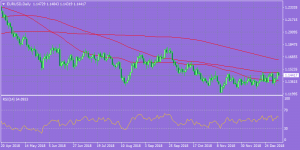Asian stock indices ended the day mixed with Japan’s Nikkei up 1%, Hong Kong’s Hang Seng Index was up 0.2%, and the Shanghai Composite was down about 0.2%. The ASX 200 index finished the session 39 points or 0.7% higher to 5722.4 after initially starting the day in the red. The index has also managed to finish at its best levels in more than five weeks.
European equity markets started the trading day in positive tones with gains across the major European indices, DAX is adding 0.64%, CAC40 is gaining 0.80%, and FTSE in London is up 0.65% at 6862.
Gold extended the Asian session retracement slide from the $1295 horizontal zone and remained under some selling pressure and now is trading at $1283 per ounce.
On the Lookout: The United Kingdom Halifax House Prices (MoM) came in at 2.2%, above forecasts (0.2%) in November. Germany Industrial Production n.s.a. w.d.a. (YoY) is down to -4.7% in November from previous 1.8%.
 Ifo research Institute in Germany came up with its latest report on European economic activity:
Ifo research Institute in Germany came up with its latest report on European economic activity:
“Economic activity in the euro area is slowing down. In Q4 2018 and the first two quarters of 2019, the economy is only expected to grow by 0.3% respectively, according to the latest forecast by the three research institutes Ifo (Munich), KOF (Zurich) and Istat (Rome). This development will mainly be due to domestic demand. The growth rate for 2018 as a whole is 1.9%. The production losses of German car manufacturers weighed on the Eurozone in Q3 2018. Industrial production in the Eurozone is expected to remain unchanged in Q4 2018, and to subsequently grow twice by just 0.2% quarter-on-quarter.
The inflation rate will reach 2.0% in the fourth quarter, which is close to the rate of just below 2.0% targeted by the European Central Bank. It will subsequently edge back down to 1.9% and 1.8% in the first two quarters of 2019 respectively. Downside risks to economic growth will increase. These risks include Brexit, escalating trade wars, the vulnerability of emerging markets and financial market volatility. The effects of the US Federal Reserve’s normalisation of monetary policy on the world economy also remain difficult to assess.”
 Trading Perspective: The recent EURUSD rally stopped at the key 100-day moving average at 1.1484 and retraced back to 1.1431 figure. Traders continue to look for developments from the Sino-US ongoing trade talks in Beijing, with headlines expected to hit the wires at some point later today. Immediate support for the pair is the 2019 low at 1.1309 and then the 2018 low at 1.1214. On the flip side, yesterday’s top at 1.1484 is the first resistance and then 1.1502 high from November 2018.
Trading Perspective: The recent EURUSD rally stopped at the key 100-day moving average at 1.1484 and retraced back to 1.1431 figure. Traders continue to look for developments from the Sino-US ongoing trade talks in Beijing, with headlines expected to hit the wires at some point later today. Immediate support for the pair is the 2019 low at 1.1309 and then the 2018 low at 1.1214. On the flip side, yesterday’s top at 1.1484 is the first resistance and then 1.1502 high from November 2018.
Carsten Brzeski, chief economist at ING, points out that Germany’s industrial production fell by 1.9% month-on-month in November, while the October drop was revised downwards to -0.8% MoM, from -0.5% MoM.
“On the year, industrial production is now down by 4.7%. The drop in industrial production was widely spread across all sectors.”
“At face value, today’s industrial production data has clearly increased the risk of a technical recession in Germany in the second half of 2018.”
“Watch out for tomorrow’s trade data. Another disappointment, combined with the high inventory build-up in 2Q and 3Q, would clearly increase the likelihood of a technical recession.”
GBPUSD is trading around the 50-day moving average at 1.2774, after it failed to breach 1.28. The pair is very vulnerable to any incoming Brexit-related headlines, UK Junior Brexit Minister Callanan saying that Article 50 will not be extended. His comments come after the UK Brexit Minister Barclay said that he had no discussions with the European Union (EU) to extend Article 50. The technical picture for the pair has improved, and an attempt to previous weekly high at 1.2815 can’t be ruled out. First support for the pair is 1.2707 previous weekly low












